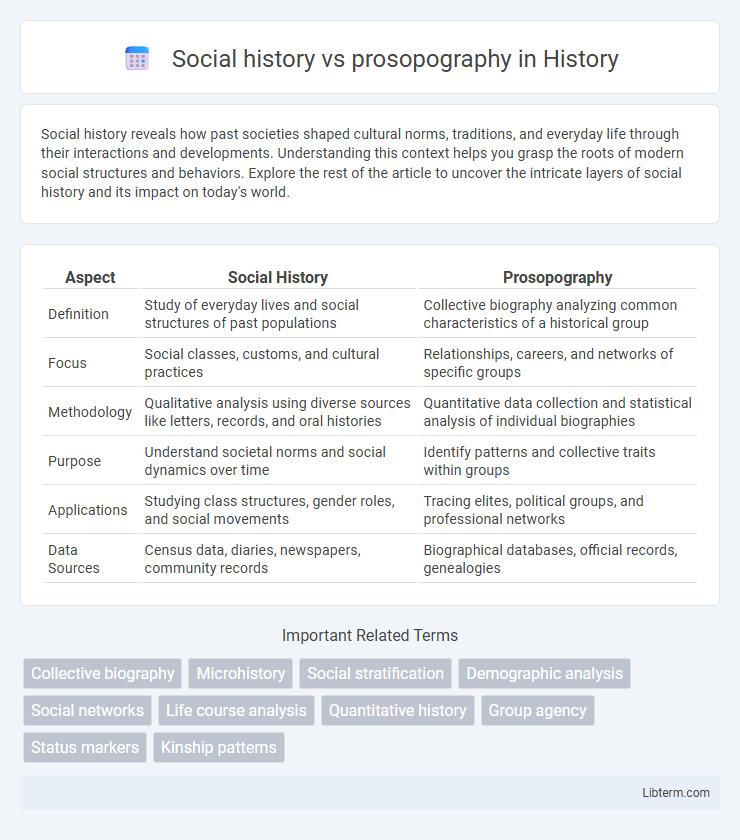Social history reveals how past societies shaped cultural norms, traditions, and everyday life through their interactions and developments. Understanding this context helps you grasp the roots of modern social structures and behaviors. Explore the rest of the article to uncover the intricate layers of social history and its impact on today's world.
Table of Comparison
| Aspect | Social History | Prosopography |
|---|---|---|
| Definition | Study of everyday lives and social structures of past populations | Collective biography analyzing common characteristics of a historical group |
| Focus | Social classes, customs, and cultural practices | Relationships, careers, and networks of specific groups |
| Methodology | Qualitative analysis using diverse sources like letters, records, and oral histories | Quantitative data collection and statistical analysis of individual biographies |
| Purpose | Understand societal norms and social dynamics over time | Identify patterns and collective traits within groups |
| Applications | Studying class structures, gender roles, and social movements | Tracing elites, political groups, and professional networks |
| Data Sources | Census data, diaries, newspapers, community records | Biographical databases, official records, genealogies |
Defining Social History
Social history is the study of societal structures, everyday life, and the experiences of ordinary people throughout history, emphasizing social classes, customs, and institutions. Prosopography, by contrast, is the systematic investigation of collective biographies within a specific group, aiming to analyze common characteristics and relationships. Defining social history involves examining demographic trends, social mobility, and cultural norms to understand how large groups interact and evolve over time.
Understanding Prosopography
Prosopography is a research method that focuses on the collective study of individuals' common characteristics within historical contexts, emphasizing patterns in social networks, family ties, and career paths. Unlike social history, which broadly examines societal structures and cultural trends, prosopography provides detailed biographical data to uncover the social dynamics and power relations among specific groups. This approach enhances understanding of historical periods by revealing how individual experiences and relationships collectively shape social and political developments.
Origins and Evolution of Social History
Social history emerged in the early 20th century as a discipline focused on the lived experiences of ordinary people, emphasizing broad societal trends and structures such as class, work, and family life. Prosopography, with roots in ancient historiography, evolved as a methodological tool to study collective biographies of specific groups, often elites, by analyzing patterns in their social networks and careers. The evolution of social history shifted from macro-scale societal analysis to include micro-level approaches like prosopography, enriching understandings of social dynamics and historical actors' interactions across time.
Development of Prosopographical Methods
Prosopography developed as a refined methodology emerging from social history, emphasizing collective biography to analyze career patterns and social networks of historical groups. It incorporates quantitative data analysis, systematic categorization, and digital databases to enhance the study of social structures across specific populations or institutions. This evolution enabled historians to reconstruct social dynamics and power relations with greater empirical rigor and interdisciplinary approaches.
Key Differences Between Social History and Prosopography
Social history examines broad societal structures and cultural patterns over time, offering a macroscopic view of daily life, social classes, and collective experiences. Prosopography focuses on constructing collective biographies of specific groups, analyzing relationships and characteristics to understand social networks across periods. The key difference lies in social history's emphasis on population-wide dynamics versus prosopography's detailed study of individual life data to reveal group behaviors.
Shared Goals and Overlapping Themes
Social history and prosopography both aim to uncover patterns within historical populations by analyzing collective behaviors and social structures. Shared goals include understanding societal dynamics, networks, and relationships through quantitative and qualitative data. Overlapping themes involve exploring class, status, and communal connections to reveal broader social contexts in history.
Methodological Approaches in Social History
Methodological approaches in social history emphasize the analysis of collective behaviors, social structures, and everyday experiences through quantitative data and archival sources to understand broader societal trends. Prosopography, as a methodological tool within social history, systematically studies groups of individuals by collecting biographical details to uncover patterns of relationships, social networks, and power dynamics. This approach enables historians to trace changes in social status, mobility, and influence, providing granular insights into historical populations beyond traditional narrative methods.
Methodological Approaches in Prosopography
Prosopography employs a systematic methodological approach that compiles and analyzes collective biographical data to identify patterns and relationships within specific social groups, contrasting with social history's broader narrative techniques. This method involves rigorous data collection from diverse sources to construct relational databases, facilitating quantitative and qualitative analysis of social structures, networks, and individual roles. By emphasizing prosopographical methodologies, researchers gain nuanced insights into the composition and dynamics of historical populations beyond traditional social history frameworks.
Notable Case Studies and Applications
Social history analyzes broad societal trends through cultural, economic, and demographic data, whereas prosopography focuses on collective biographies to identify patterns among specific groups. Notable case studies include the study of French Revolution participants in prosopography revealing networks of influence, contrasted with social history's detailed analysis of industrialization's impact on working-class life in 19th-century England. Applications of prosopography extend to political elite studies, while social history informs public policy by tracing social mobility and class dynamics over time.
Impact on Modern Historical Research
Social history emphasizes the study of everyday lives and societal structures of ordinary people, providing broad contextual insights into historical periods. Prosopography examines collective biographies to uncover patterns within specific groups, enhancing understanding of social networks and power dynamics. Together, these methods enrich modern historical research by offering complementary perspectives that deepen analysis of social complexities and historical change.
Social history Infographic

 libterm.com
libterm.com